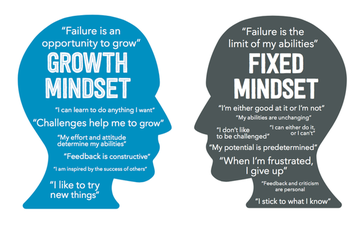
It’s the most magnificent idea. Just what will it take to make it real?
“She knows just how it will look. She knows just how it will work”, the story goes. “Easy-peasy. But making the most magnificent thing turns out to be harder than she thinks. She measures, hammers, fastens, and adjusts again and again, but the thing just keeps turning out wrong. If only the thing WOULD JUST WORK!”
She tries and tries again. But it is still wrong. The girl gets mad. Mad enough to want to quit.
“I am no good at this,” the girl says.
What happens then? Does she persevere? Or give up? How does she respond when she encounters a challenge?
In 2006, a psychologist and a professor at Stanford University, Carol Dweck, Ph.D., wrote a book called “Mindset: The New Psychology of Success.” In it, she introduces the idea of mindsets, or beliefs about yourself.
As a scientist and researcher, Dweck discovered in the course of her career that people are predisposed to holding two separate mindsets, the fixed mindset and the growth mindset, and that the differences in how people think are already apparent in early childhood.
These differences are particularly evident in how people respond to failure.
People with the fixed mindset believe that their success or failure is a direct reflection of their innate abilities. In other words, if they succeed, it’s proof that they are smart and capable. On the other hand, if they encounter a particularly difficult challenge, it’s proof that they are lacking in ability. They are less likely to try again after a failed attempt, because they are afraid of being perceived in a negative way, by themselves and others.
Those with the growth mindset, however, see the results of their efforts not as a reflection on their ability, but as evidence of how hard they worked to solve the problem. They approach problems with enthusiasm and see them as an opportunity to learn and get better. If they meet with a challenging problem, their confidence in themselves does not deteriorate – but their resolve to find the solution grows.
According to Dweck, the two mindsets lie on a continuum – the way you think is not a black-and-white dichotomy. She argues that with effort and awareness you can put yourself into the growth mindset even if you start out with the fixed.
And that’s what ultimately happens with our little heroine from “The Most Magnificent Thing.” She goes for a walk, and with the help of a friend, she is able to gain a new perspective.
Her previous failed attempts are no longer ALL WRONG. “There are some parts of the WRONG things that are really quite RIGHT. The bolts on one, the shape of another, the wheel-to-seat ratio of the next. There are all sorts of parts that she likes!”
She gets back to work. By evening time, the girl is finished.
She’s made The Most Magnificent Thing. And best of all, she gets to enjoy it with her friend.





 RSS Feed
RSS Feed